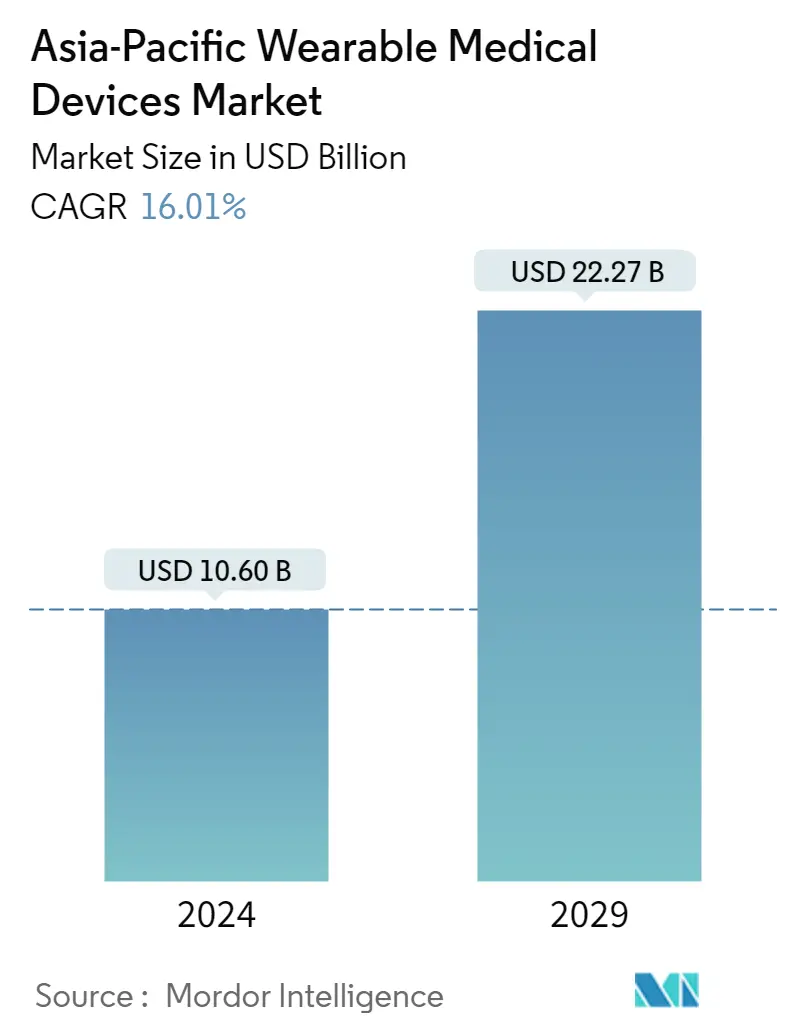Market Size of Asia-Pacific Wearable Medical Devices Industry

| Study Period | 2019 - 2029 |
| Base Year For Estimation | 2023 |
| Forecast Data Period | 2024 - 2029 |
| Market Size (2024) | USD 10.60 Billion |
| Market Size (2029) | USD 22.27 Billion |
| CAGR (2024 - 2029) | 16.01 % |
Major Players
*Disclaimer: Major Players sorted in no particular order |
Asia-Pacific Wearable Medical Devices Market Analysis
The Asia-Pacific Wearable Medical Devices Market size is estimated at USD 10.60 billion in 2024, and is expected to reach USD 22.27 billion by 2029, growing at a CAGR of 16.01% during the forecast period (2024-2029).
COVID-19 has expedited the technological transition in the medical device industry that is currently underway. The outbreak has resulted in an unprecedented focus on public health, which has led to an increase in preventive and long-term patient care aids and equipment at the consumer level. According to the study titled "The Rise of Wearable Devices during the COVID-19 Pandemic: A Systematic Review" published in the Journal of Sensors in August 2021, remote monitoring of COVID-19 symptoms is in high demand in healthcare. Companies manufactured a variety of IoT-based devices and wearables last year, with promising findings in terms of high accuracy in identifying patients in the prodromal phase and monitoring symptoms such as breathing rate, heart rate, temperature, and so on. Such studies demonstrate the positive impact of COVID-19 on market growth.
Currently, remote monitoring of COVID-19 symptoms is in high demand in healthcare across the region, and several companies are engaged in developing and manufacturing devices that aid in no-contact tracking of patient symptoms. For instance, in March 2021, EOFlow, a wearable drug delivery solution provider, launched a new smartphone application for integration with wearable insulin delivery devices, which has also been allowed to be sold in South Korea.
Moreover, increasing technological breakthroughs and innovations, rising per-capita wealth in developing countries, and the simplicity of use and interpretation of medical devices are all driving the regional industry forward. For instance, in December 2021, with the release of the Huawei Watch D in China, Huawei added a smartwatch to its product portfolio. It's the company's first wristwatch with a blood pressure monitor on the wrist. The Chinese Drug Administration has designated the smartwatch as a Class II medical device.
Thus, owing to the abovementioned factors, the market is expected to show growth over the forecast period. However, the high cost of the products is expected to impede the growth of the market.
Asia-Pacific Wearable Medical Devices Industry Segmentation
As per the scope of the report, wearable medical devices can diagnose or monitor medical conditions when combined with digital health information worn over the body. Wearable devices are easy to use, cordless, and can provide information about various factors, such as heart rate, blood pressure, weight, sleeping habits, and other factors. The Asia-Pacific Wearable Medical Devices Market is segmented by Product Type (Wearable Vital Sign Monitor (Wearable Heart Rate Monitor, Wearable Activity Monitor, Wearable Electrocardiograph, and Wearable Sleep Monitor), Wearable Fetal Monitor and Obstetric Device, Neuro-monitoring Device, Respiratory Therapy Wearable Device, Glucose/Insulin Monitoring Wearable Device, and Other Wearable Devices), Application (Sports and Fitness, Remote Patient Monitoring, and Home Healthcare), Device Type (Watch, Wristband, Clothing, Ear Wear, and Other Device Types), and Asia-Pacific (China, Japan, India, Australia, South Korea, and Rest of Asia-Pacific). The report offers the value (in USD million) for the above segments.
| By Product Type | ||||||
| ||||||
| Wearable Fetal Monitor and Obstetric Device | ||||||
| Neuro-monitoring Device | ||||||
| Respiratory Therapy Wearable Device | ||||||
| Glucose/Insulin Monitoring Wearable Device | ||||||
| Other Wearable Devices |
| By Application | |
| Sports and Fitness | |
| Remote Patient Monitoring | |
| Home Healthcare |
| By Device Type | |
| Watch | |
| Wristband | |
| Clothing | |
| Ear Wear | |
| Other Device Types |
| Geography | |
| China | |
| Japan | |
| India | |
| Australia | |
| South Korea | |
| Rest of Asia-Pacific |
Asia-Pacific Wearable Medical Devices Market Size Summary
The Asia-Pacific wearable medical devices market is poised for significant growth, driven by technological advancements and an increasing focus on health monitoring. The COVID-19 pandemic has accelerated the adoption of these devices, as there has been a heightened demand for remote monitoring solutions to track symptoms and manage health conditions without direct contact. This shift has led to the development of various IoT-based wearables that offer high accuracy in monitoring vital signs such as heart rate and temperature. The region's market is further bolstered by rising per-capita income in developing countries, making these devices more accessible and easier to use. Innovations like Huawei's smartwatch with a blood pressure monitor and EOFlow's wearable insulin delivery solution exemplify the ongoing technological breakthroughs that are propelling the market forward.
The market's expansion is also fueled by the increasing prevalence of lifestyle-related diseases, such as diabetes and obesity, particularly in countries like India and China. As awareness of the importance of early diagnosis and preventive healthcare grows, the demand for wearable medical devices is expected to rise. The proliferation of gyms and fitness centers, coupled with the popularity of sports and fitness wearables, is contributing to this trend. Key players in the market, including Garmin, Apple, and Fitbit, are employing strategies like strategic acquisitions and partnerships to enhance their market presence. Despite the high cost of these devices posing a challenge, the overall outlook for the Asia-Pacific wearable medical devices market remains positive, with continued growth anticipated over the forecast period.
Asia-Pacific Wearable Medical Devices Market Size - Table of Contents
-
1. MARKET DYNAMICS
-
1.1 Market Overview
-
1.2 Market Drivers
-
1.2.1 Increasing Technological Advancements and Innovations
-
1.2.2 Increasing Per-capita Income in Developing Countries
-
1.2.3 Ease-of-use and Interpretation of Medical Devices
-
-
1.3 Market Restraints
-
1.3.1 High Cost of Wearable Devices
-
1.3.2 Unfavorable Reimbursement Issues
-
-
1.4 Porter's Five Force Analysis
-
1.4.1 Threat of New Entrants
-
1.4.2 Bargaining Power of Buyers/Consumers
-
1.4.3 Bargaining Power of Suppliers
-
1.4.4 Threat of Substitute Products
-
1.4.5 Intensity of Competitive Rivalry
-
-
-
2. MARKET SEGMENTATION (Market Size by Value - USD million)
-
2.1 By Product Type
-
2.1.1 Wearable Vital Sign Monitor
-
2.1.1.1 Wearable Heart Rate Monitor
-
2.1.1.2 Wearable Activity Monitor
-
2.1.1.3 Wearable Electrocardiograph
-
2.1.1.4 Wearable Sleep Monitor
-
-
2.1.2 Wearable Fetal Monitor and Obstetric Device
-
2.1.3 Neuro-monitoring Device
-
2.1.4 Respiratory Therapy Wearable Device
-
2.1.5 Glucose/Insulin Monitoring Wearable Device
-
2.1.6 Other Wearable Devices
-
-
2.2 By Application
-
2.2.1 Sports and Fitness
-
2.2.2 Remote Patient Monitoring
-
2.2.3 Home Healthcare
-
-
2.3 By Device Type
-
2.3.1 Watch
-
2.3.2 Wristband
-
2.3.3 Clothing
-
2.3.4 Ear Wear
-
2.3.5 Other Device Types
-
-
2.4 Geography
-
2.4.1 China
-
2.4.2 Japan
-
2.4.3 India
-
2.4.4 Australia
-
2.4.5 South Korea
-
2.4.6 Rest of Asia-Pacific
-
-
Asia-Pacific Wearable Medical Devices Market Size FAQs
How big is the Asia-Pacific Wearable Medical Devices Market?
The Asia-Pacific Wearable Medical Devices Market size is expected to reach USD 10.60 billion in 2024 and grow at a CAGR of 16.01% to reach USD 22.27 billion by 2029.
What is the current Asia-Pacific Wearable Medical Devices Market size?
In 2024, the Asia-Pacific Wearable Medical Devices Market size is expected to reach USD 10.60 billion.

